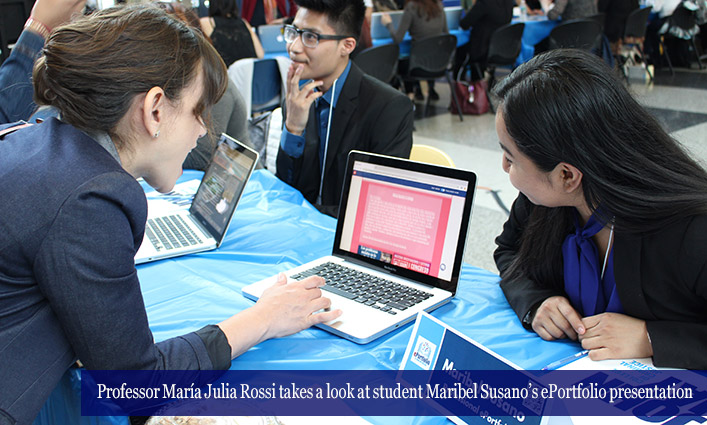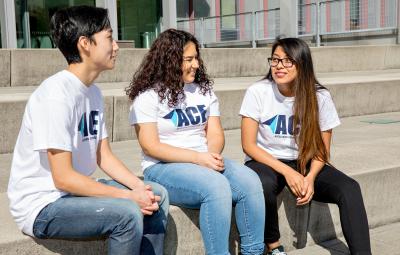
This year’s ten-day Research and Creativity Expo allowed everyone in the John Jay community to be inspired by the inventive research projects conducted at the College. Held from May 1-10, the projects came from every department imaginable, including PRISM, McNair, the Student Academic Success Program, and Honors and Macaulay. Kicking off the event, President Karol V. Mason spoke at the opening ceremony where she told the audience about the value of this Expo. “This is an important week for us. We are here to view the hard work of our determined students here at John Jay,” said Mason. “And, what we are going to see is the innovative work that you all are doing. Your work is not just for the John Jay community, or the faculty, its work that can change the world.”

“Your work is not just for the John Jay community, or the faculty, its work that can change the world.”—President Karol V. Mason
Turning the mic over to Anthony Carpi, Dean of Research and Professor in the Department of Sciences, he encouraged the audience to take the time to attend the planned events. “This is going to be an exciting week for research. Over the next 10 days, there are going to be all sorts of exciting events from musical performances, poster sessions, and awards,” said Carpi. “We had over 100 faculty members mentoring students on their projects. So, I encourage all of you to attend the events and support your fellow classmates and all the work they’ve done.” Eager to share their project with the John Jay community, we spoke to several student presenters to learn more about their projects and what this Expo means to them and their goals for the future.
Isaac Paredes '21, PRISM

I studied Membrane-Bound Catechol-O-Methyltransferase (MB-COMT) DNA Methylation and Genetic Variation in Saliva of Healthy individuals to see if there were early epigenetic markers that could be used to determine if differences exist between individuals with different polymorphism within their DNA. We focused on the membrane-bound because there's a high concentration in the prefrontal cortex which has been shown to have a direct correlation on a person’s behavior, personality and addiction. The goal was try to find any difference in the DNA early enough to treat it and offer people the best life possible. In the future I would like to be in a Ph.D. program for animal behavior and eventually go into a professorship in conversational research. This Expo has taught me how to properly explain my work to the science community.
Maribel Susano ’20, Humanities and Justice

For my ePortfolio presentation, I combined my academic and professional experiences, specifically my internships and courses. My overall goal is to tell the audience about how these courses and my experiences have further inspired me to attend law school and study immigration law. One of the internships highlighted in my ePortfolio is my internship with U-LAMP, where I worked with immigration attorneys. Seeing how the immigration system works in this country, reinforced for me that this was what I wanted to pursue in the future.
Raider Rodriguez '20, PRISM
“I won the 2019 CSTEP Conference Award for my research. This award showed me that the effort I put into this research study was worth it.”—Raider Rodriguez
My project is titled “The Analytical Determination of Methylone and Metabolites in Brain Tissue by LC-MS/MS.” Methylone is a substitute and in pharmacology has a profile similar to 3.4-methylenedioxy-methamphetamine (MDMA). Although it’s illegal, it poses a public health risk because it’s promoted as bath salts. For this research, we tested rat brains for methylone and its metabolites and found different concentrations of methylone and metabolites in the brains. Our goal is to use the analytical method to study pharmacological behavior of methylone. Participating at this Expo has taught me how actual research is done because sometimes what you do in the classroom and in the lab is not the same. I won the 2019 CSTEP Conference Award for my research. This award showed me that the effort I put into this research study was worth it, and it further cemented my dream of pursuing a Ph.D. in pharmacology and working for a pharmaceutical company or in academia.
 Georgina Alexander '21, Forensic Science
Georgina Alexander '21, Forensic Science
My project is about Socially Awkward, a club here at John Jay founded in 2014. Our whole mission is about promoting self-acceptance throughout the John Jay community by creating spaces and events where people can come and feel comfortable in making friends and getting involved. We are actually the second biggest club on the John Jay app, and we are very proud of that. We grew from a small club into something much larger over the last two years. Our dream is to expand and reach all the people at John Jay who don't know how to get out of their shell. We want to help John Jay students feel more comfortable so that they have a better college experience.
 Johnny Ventura '22, Forensic Science major
Johnny Ventura '22, Forensic Science major
This project was my ePortfolio from my English class with Professor Claudia Zuluaga. I chose to showcase assignments that I thought were creative and expressed emotions. One assignment that I am proud of is “The Story of My Name.” For this, we had to describe how our name is special to us and what it makes us feel. Everyone says that I have a pretty cool name and that it sounds heroic. There’s a singer that has the same name as me, and people do compare me to him, but we are two entirely different people.
Hannah Chu ’19, PRISM
“Doing this research for this expo has helped me get one step closer to my dream of working for NASA.”—Hannah Chu
A 2016 study found that 39.9 percent of homicide victims had positive blood alcohol content (BAC) of ≥ 0.01 percent. These victims and other alcohol-related deaths can go undiscovered for a period of time. In these cases the normal pathological means of determining the time of death is no longer reliable, and using insects may be the only reliable method to discover a post-mortem interval (PMI). One of my biggest dreams is to work for NASA. They have a Fruit Fly Lab at the International Space Station where they study how space affects the fruit fly biology. Doing this research for this expo has helped me get one step closer to my dream of working for NASA.



